Lipsey’s Restores the Smith & Wesson Model 686 Plus
Although the .357 Magnum was introduced by S&W in 1935, the first iteration was a large N-frame revolver that was individually-made to the customer’s specifications. The cartridges popularity increased measurably when S&W produced more affordable .357 Magnum revolvers like the Model 19 Combat Magnum and Model 28 Highway Patrolman in the late 1950’s. Many cops found the N-frame Model 28 to bulky, while the K-frame Model 19 was handy, but wasn’t made to take a steady diet of .357 Magnum ammunition. S&W solved this problem in 1980, with the introduction of the Distinguished Combat Magnum Model 586/686. They were based on the more rugged L-frame and were built to withstand full-time .357 Magnum use. LE agencies immediately adopted these new wheelguns, and they remained popular until semi-automatic pistols began taking their place in the late 1980’s-early 1990’s.
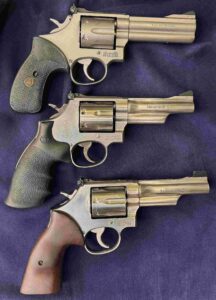
In 1980 S&W introduced the L-frame Model 686 (top) then in 1998 came a limited edition Model 686 Plus Mountain Gun (middle) and now a new Model 686 Plus Mountain Gun for 2025 (bottom) from Lipsey’s.
The S&W Model 686 Plus Mountain Gun Debuts
In the mid-1990’s, S&W came out with a series of revolvers they named the “Mountain Gun.” They featured tapered, half-lug barrels that cut down on the revolver’s weight. Several models were offered; an N-frame Mountain Gun in .45 Colt, another N-frame Mountain Gun in .41 Magnum, and an L-frame .357 Magnum Mountain Gun. The .357 Magnum Mountain Gun was different as its platform was the Model 686 Plus. These 686 variations first appeared in 1996 and had a 7-shot cylinder, but like the standard Model 686, its barrel had a full-length underlug. When S&W introduced the Model 686 Plus Mountain Gun in 1998, it had a tapered, half-lug barrel. Its model designation was 686-5 and came with a satin stainless finish, pinned black ramp front sight, black adjustable rear sight, a color case-hardened hammer and target trigger, plus Hogue combat-type Mono-Grips. At the time, they didn’t have the unpopular internal safety lock. It weighted 35.5 oz., a bit less than the standard 4-inch Model 686. It was a special run for S&W stocking dealers and production only lasted for a year.
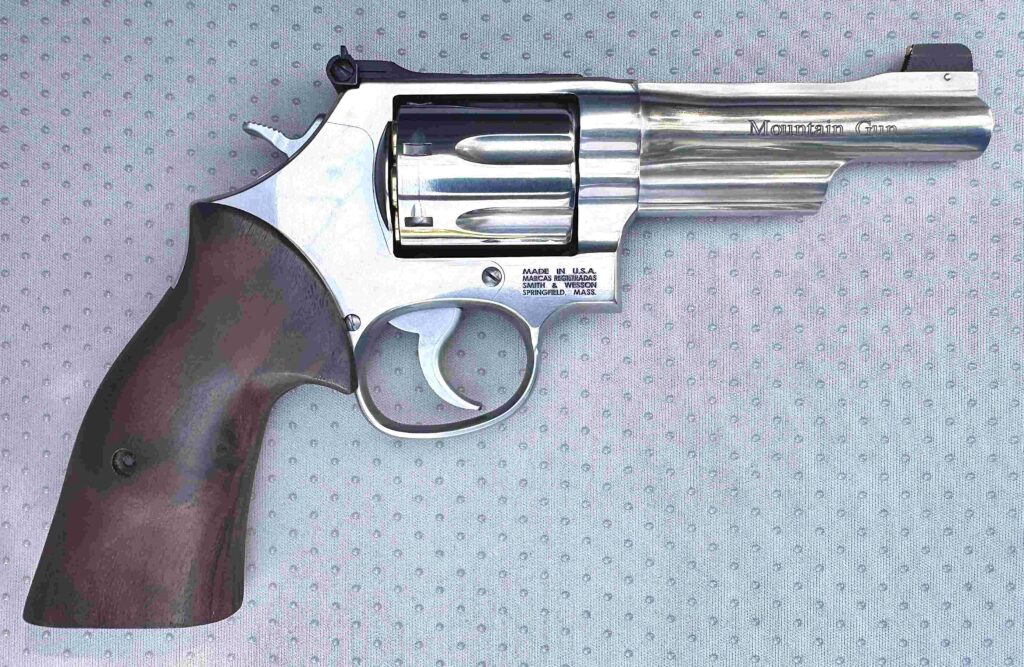
Like its predecessor, the new Mountain Gun is based on the S&W L-frame, and is crafted of stainless-steel with a brushed finish.
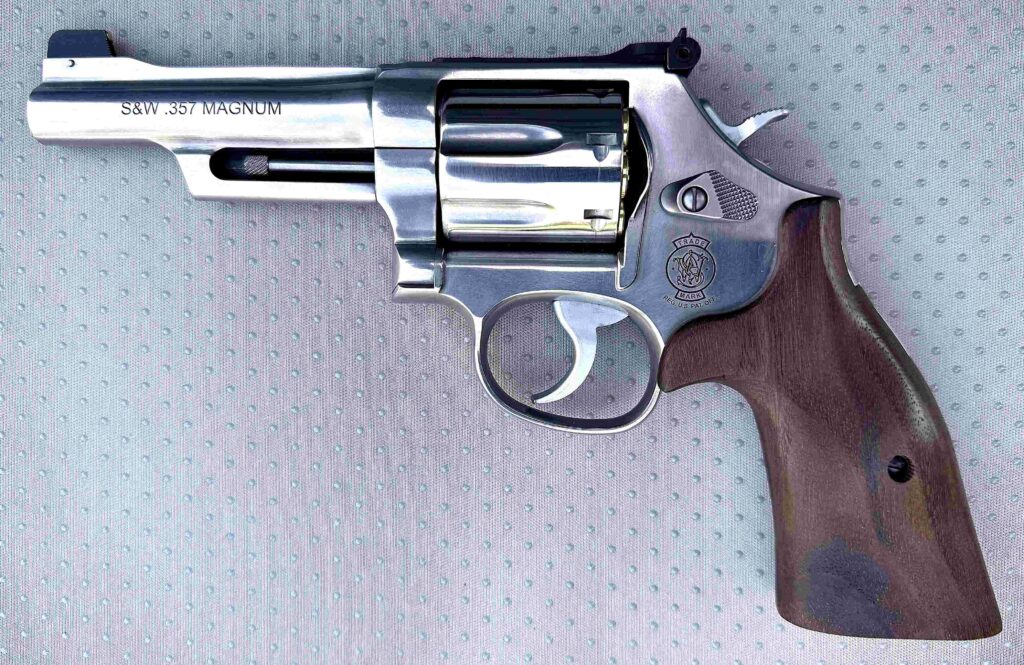
One difference between the old and new Mountain Guns is the 4.25” barrel on the Lipsey’s version; what is missing is the security lock hole in the frame.
Lipsey’s is very attuned to its customer base and what is marketable, so at the 2025 SHOT Show, they presented one of their latest Exclusives, a new S&W Model 686 Plus Mountain Gun (686-7). While it looks much like the 1998 version, there are several prominent differences. The first notable item, is the pinned black patridge front sight with a gold bead. Not as noticeable is the 4.25” barrel that’s 0.25” longer than the original. The cylinder lockup is also different. If you look at the half-lug you won’t see the locking pin that engages the tip of the ejector rod. It’s been replaced by a ball-dent lockup on frame/crane, and the ejector rod is thinner. The barrel forcing cone has been reinforced with less of it exposed outside the frame, and the 7-shot cylinder has been beveled on the front edges. The frame itself appears thicker just below the rear sight. This new 686 Plus Mountain Gun has a hammer and trigger that have been flash-chromed. A real show-stopper is the Tyler Gun Works Bear Hug grips, that are smooth-finished walnut, with palm swells, and make the round-butt frame into a square-butt configuration.
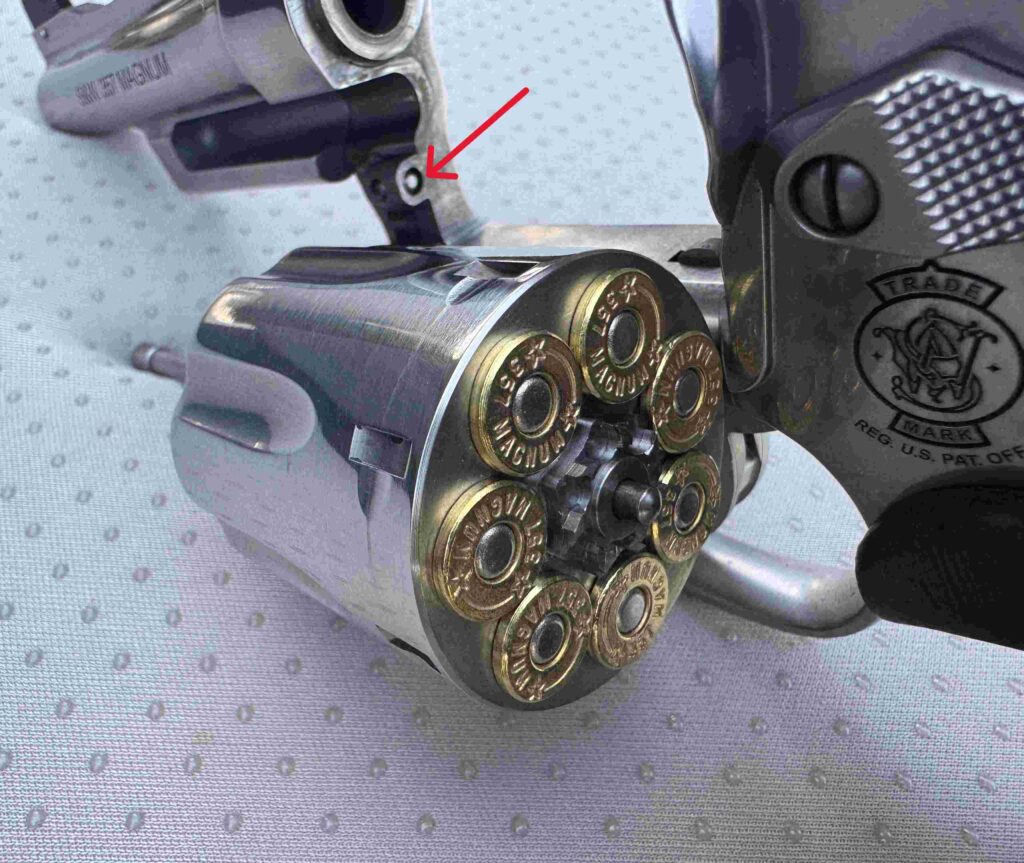
What sets the Model 686 Plus apart is its 7-shot cylinder; also note the red arrow is pointing to the new frame/crane cylinder locking point.
The new .357 Magnum Mountain Gun has an empty weight of 35 oz. and a brushed stainless finish. Metal to metal and wood to metal fit are first rate. The smooth-faced trigger is .312-inches wide; the hammer spur is the narrow style and checkered. The single action pull weight averaged 5 lbs. 3 oz.; while the double action pull was 11 lbs. 7 oz. according to my Lyman Trigger Pull Gauge. The SA pull is best described as crip, while the DA pull is straight-through and even. Differing from most of the recent-production S&W revolvers, the new Mountain Gun has no internal lock. It comes in a blue plastic, foam rubber-lined carrying case, with a safety padlock and owner’s manual.
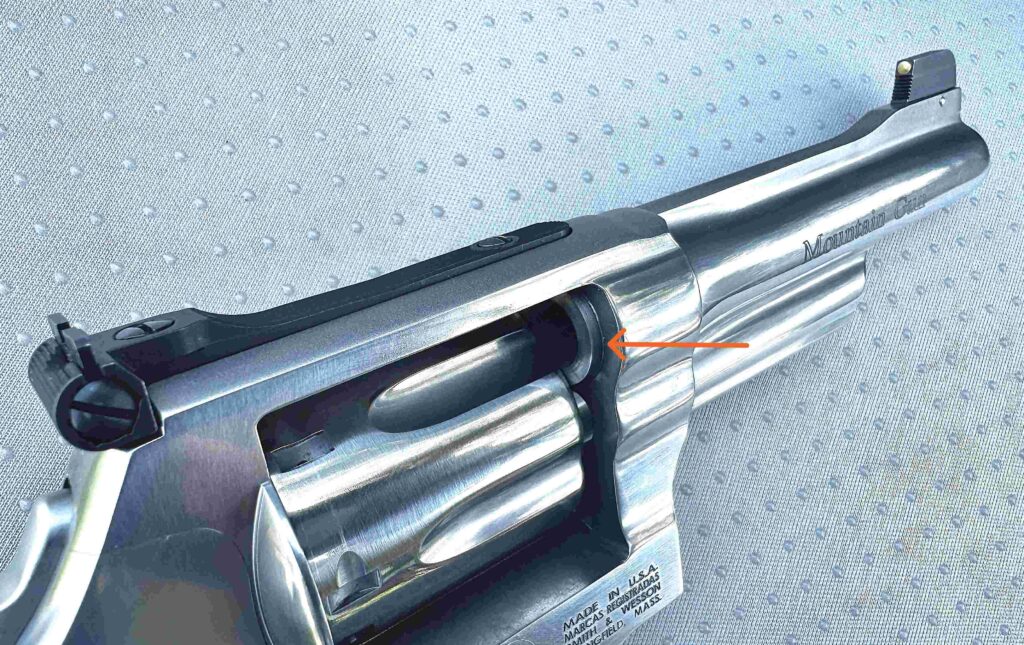
Here you can see the fully adjustable rear sight, the reinforced barrel forcing cone (orange arrow), and the gold bead front sight.
Lead and Leather
I used three .357 Magnum loads and two .38 Special loads for the Model 686 Plus Mountain Gun T&E. Black Hills supplied their HoneyBadger Ammunition in .357, it features a 127 gr. solid copper bullet, with an X-shaped nose, and flutes to penetrate barriers, then transmit bullet energy to the target. Doubletap provided their .357 load with a 140 gr. solid copper hollow-point; maximized for 4-inch barrel revolvers. The third .357 load was from PPU Ammunition (Serbia) and it uses a conventional 158 gr. exposed lead nose JHP bullet. I selected Remington-UMC standard pressure .38 Special cartridges for a practice load; they have a 130 gr. blunt-nose FMJ bullet. A cartridge from yesteryear is the Winchester Super-X; it’s a .38 Special +P load, with a 110 gr. exposed lead nose JHP bullet.
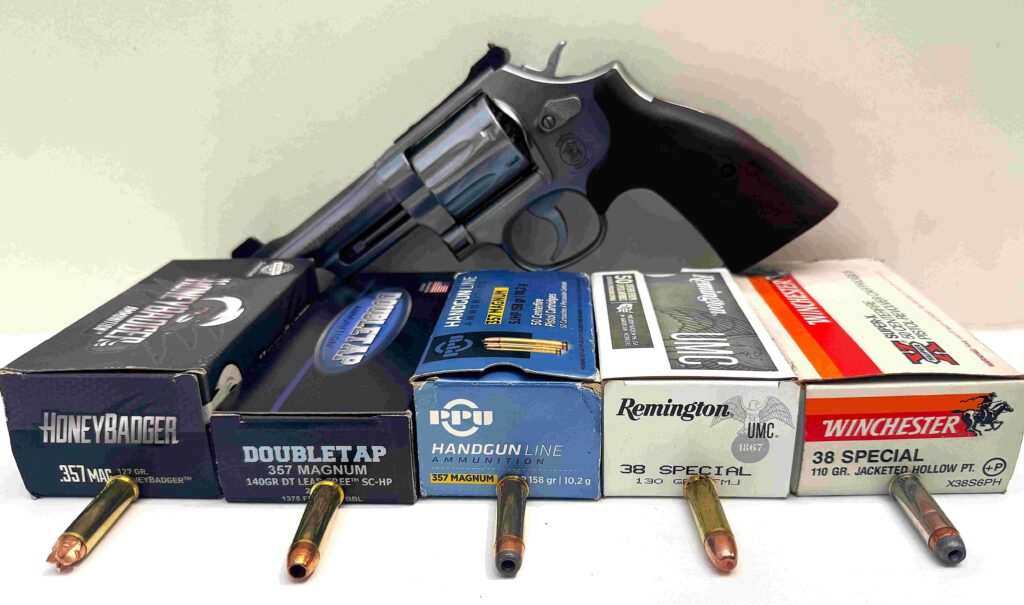
Shown are the five different .357/.38 cartridges that were used in the Model 686 Plus
Mountain Gun T&E.
For a belt holster I chose the Combat Master Belt Holster from Galco. It makes a gun like the 686 Plus concealable. Made from premium steerhide, it’s a high-ride, open-top, pancake design, featuring a butt-forward cant, is hand-molded for security, and has two 1.75-inch belt slots. I paired the holster with a Galco SB2 Casual Holster Belt; it too is premium steerhide, double-thick, 1.5-inches wide, with 7 holes, and a brass buckle. Both belt and holster are tan. Simply Rugged Holsters sent me one of their new products called the Sidewinder Speedloader pouch. It carries a single speedloader in a leather tunnel, with reinforced leather strips at both ends to keep the speedloader secure, and has a snap closure. It fits on the belt using a Kydex loop that is 1.75” wide. I paired it with an HKS Model 587 speedloader and wore it upside down, it worked better.
Range Time
My first chore at the range was to check the sights on the Lipsey’s 686 Plus Mountain Gun. I sent a bullseye target down to the 15-yard line, and using Black Hills remanufactured .38 Special 148 gr. wadcutter loads, I fired 5 shots then made some windage adjustments. Then, I set up my Garmin Xero C1 Pro chronograph to get velocity measurements with the test ammo; the information is in the performance chart. To evaluate the accuracy potential, I sent double bullseye targets down to 15 yards, and put my Ransom Steady Rest on top of the range bench. Three 5-shot groups were fired SA with each of the 5 test cartridges. My best 5-shot group was made with the Remington .38 Special load; it measured 1.43”. I had a group with the Black Hills .357 HoneyBadger that had 4 shots in a 0.83” cluster, but a stray opened it up to 2.06.” Overall average for the fifteen groups was 2.36” and all the data is in the performance table.
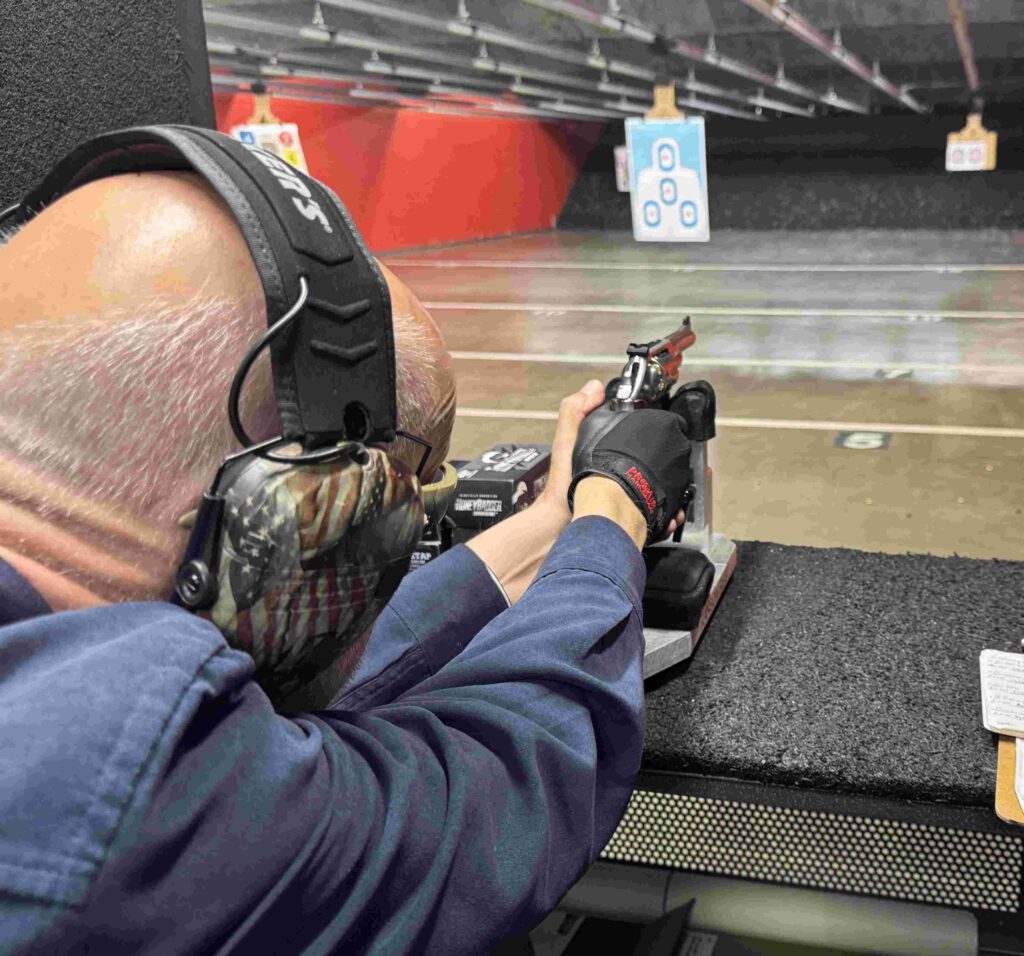
Accuracy potential testing was done using a Ransom Steady Rest on the bench, shooting three 5-shot groups, single action at 15 yards, with the test ammo.
A fun exercise, one that I’ve done in the past with old and new versions of the same gun, is a shoot-off. I brought along my 1998 Model 686 Plus Mountain Gun to pit against the 2025 Mountain Gun, using the Black Hills wadcutter cartridges. Shooting was again from the bench, SA, 5 shots with each revolver, using a hold 6 o’clock of the red center aiming point of the target. Both guns produced a nice 4-shot group and then a stray enlarged them. With the 2025 Mountain Gun I had 4 impacts that measured 0.99”, with a flyer opening it up to 1.92”. The 1998 Mountain Gun produced 4 shots in a 1.35” cluster, and one impact an inch below the rest, for a 1.48” group. Not a great deal of difference, and I felt the two revolvers more or less tied.
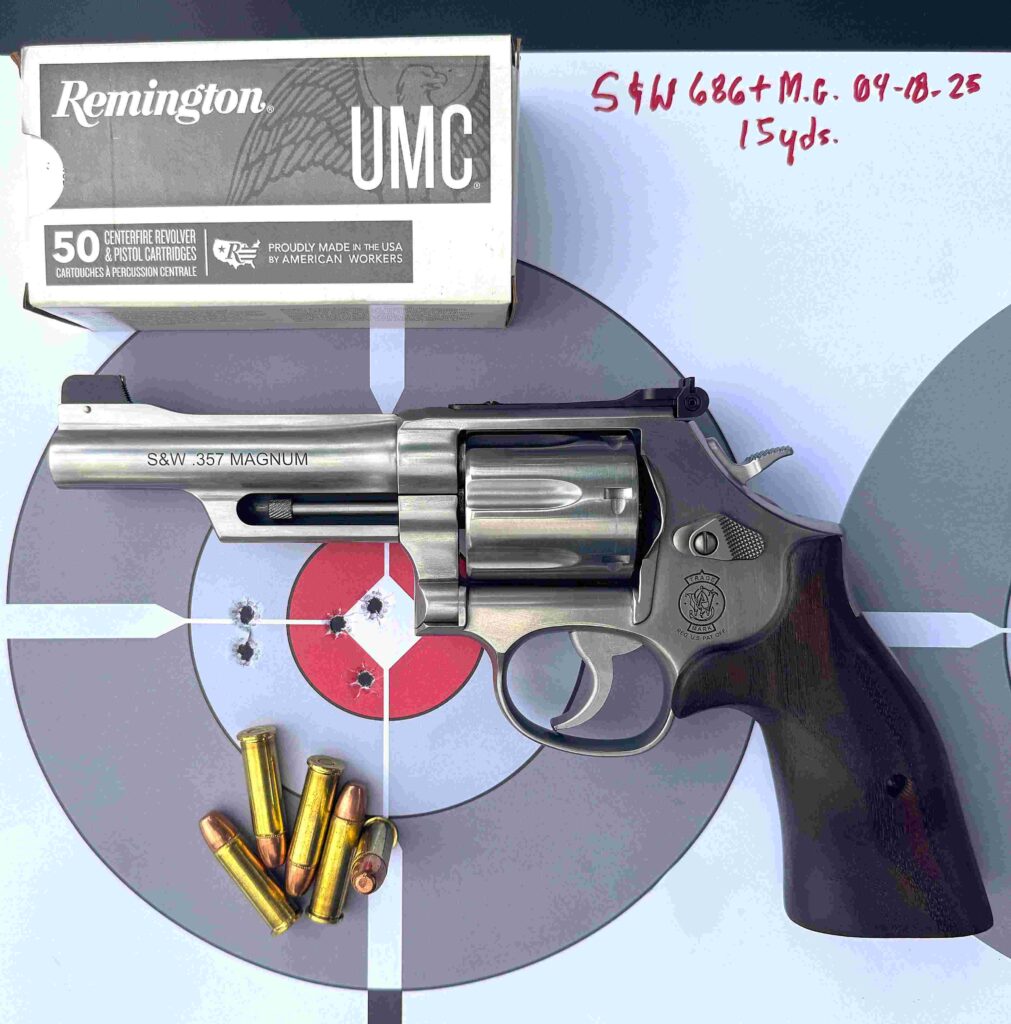
The tightest 5-shot group measured 1.43” and was made using the Remington UMC .38 Special cartridges.
For some practical shooting, I used an FBI Q silhouette target. The course would be 21 rounds, with shooting at 5, 7, and 10 yards. I loaded the new 686 Plus Mountain Gun with 7 rounds, and holstered; then the HKS speedloader was loaded with 7 rounds, and put in the Sidewinder pouch. At 5 yards, I shot 4 rounds from a point shoulder stance, strong-hand only, sans sights; then transitioned to my support-hand, and fired the remaining 3 shots. Doing a speed reload, I did a 360° scan for bad guys, and re-holstered. I also re-filled the speedloader, and moved the target to 7 yards. Then, I drew the revolver, and using a two-handed, isosceles stance, fired 3 aimed shots, center-mass. I assessed the situation with the gun at a high-ready, then re-engaged with 3 more shots center-mass, and one head shot. Again, a speed reload was made, and the gun holstered. The target was now moved to 10 yards, and I repeated the 7-yard drill.
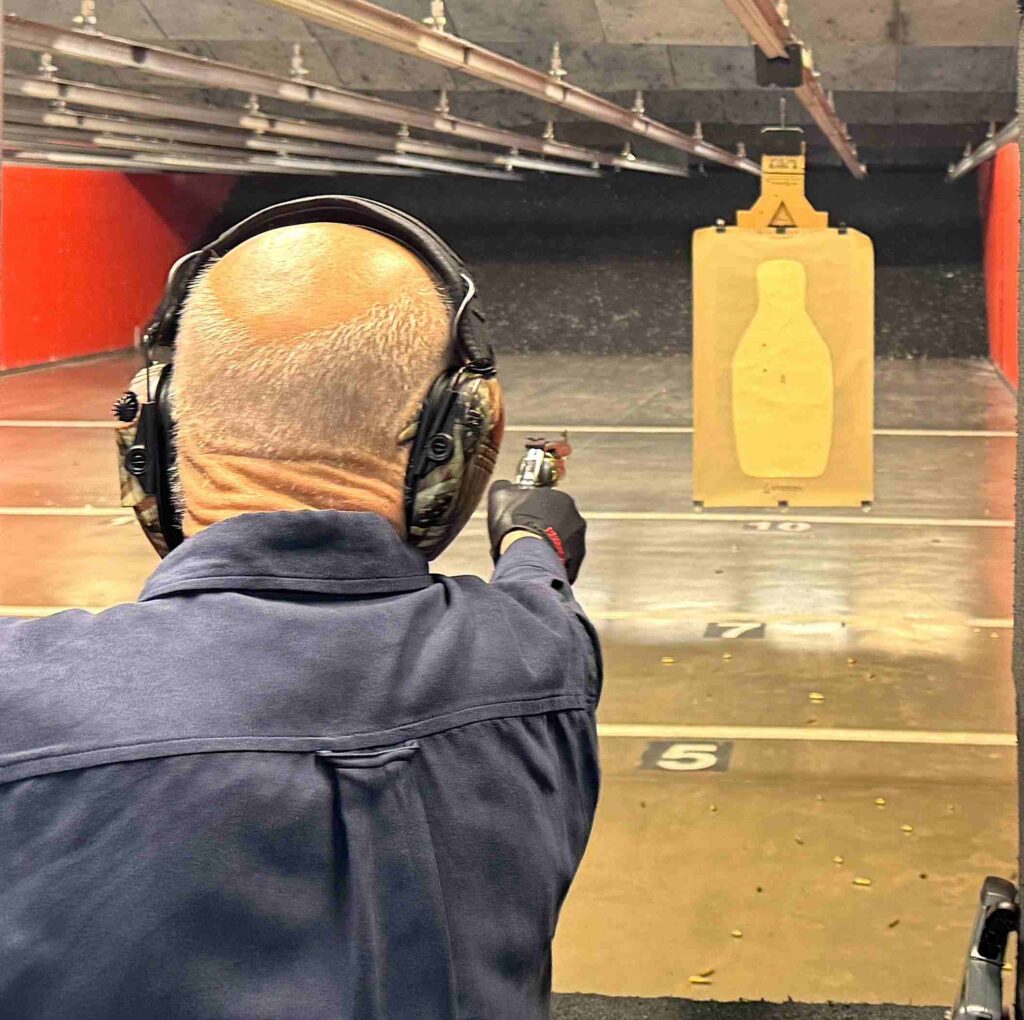
A practical shooting course was fired with distances of 5, 7 and 10 yards, using an FBI Q target; it was shot twice with .38 Special and .357 Magnum cartridges.
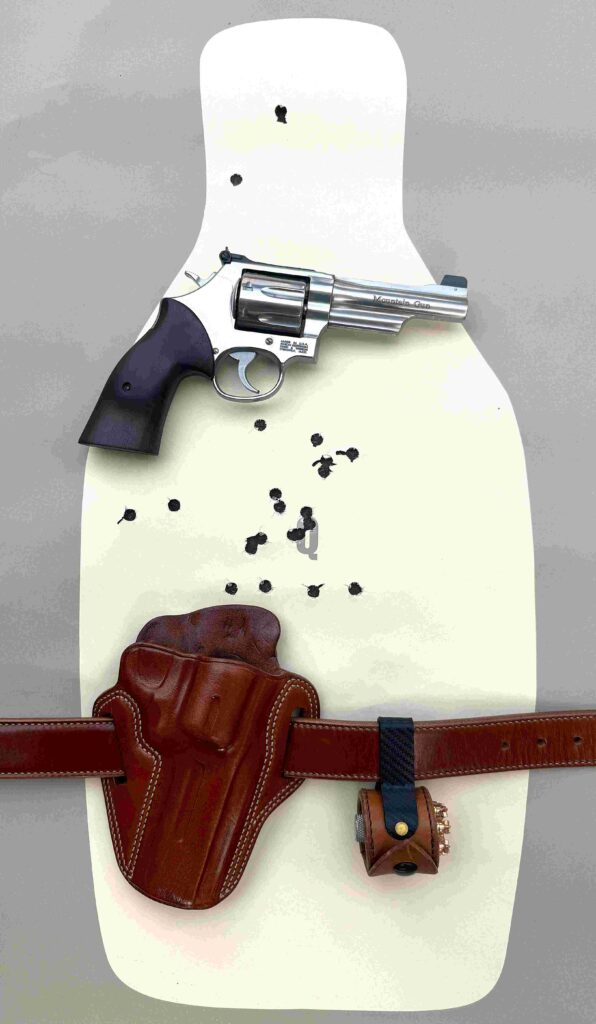
This is the Q target after the second run wit the .357 Magnum ammo; below is the Galco holster and belt, plus the Simply Rugged Sidewinder speedloader pouch.
All in a Day’s Work
I used the Remington .38 Special loads the first time I ran the course. All my shots were in the silhouette, but the pattern was bigger than I liked, plus my two head shots would’ve just made furrows in the bad guy’s scalp. I then re-shot the course using the Black Hills .357 Magnum HoneyBadger cartridges. They were a bit challenging to insert into the cylinder with the speedloader, but my shot pattern was about 3-inches smaller, and my two head shots more to my liking. I was a little concerned that the Tyler Bear Hug grips would make shooting Magnum loads uncomfortable, and I used a thin ProAir shooting glove, but the recoil just wasn’t that bad. I felt the palm swells helped control the muzzle flip. The S&W 686 Plus Mountain Gun ran without incident, empty cases ejected just fine, and there were no issues. My one thought at the end of the session was, “Why didn’t they come out with this in the late 1970’s when I was a wheelgun carrying lawman?” For more information, go to www.lipseys.com.
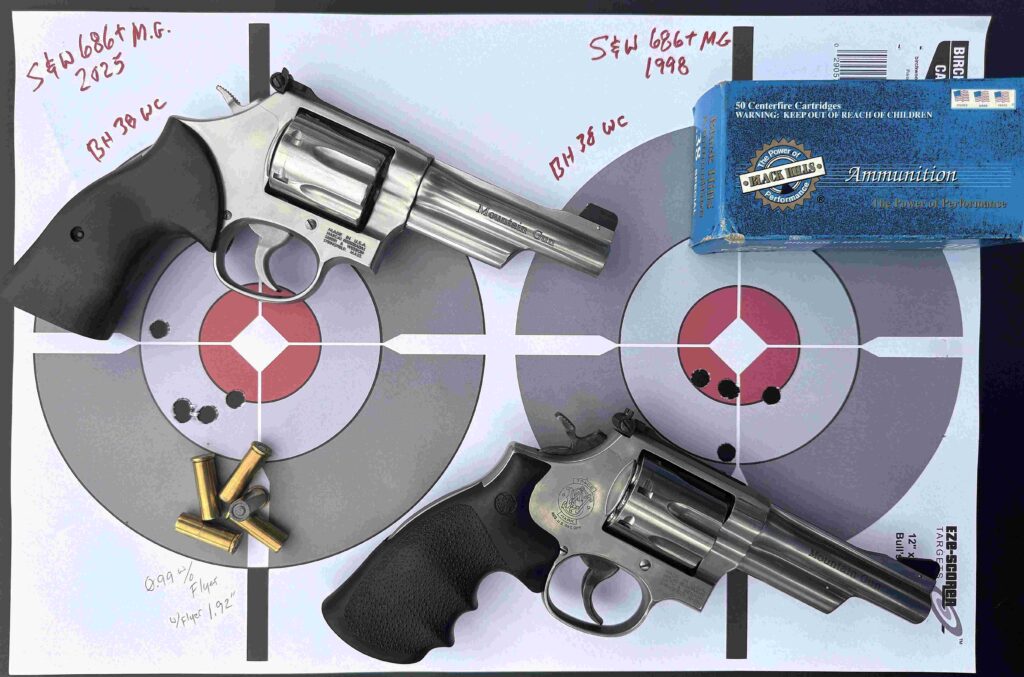
This shows the results of the Model 686 Plus (1998) vs. the Model 686 Plus (2025) shoot-off; a flyer ruined both 5-shot groups and both were close size-wise.
Lipsey’s S&W Model 686 Plus Mountain Gun Specifications
MECHANISM: Traditional DA/SA revolver
CALIBER: .357 Magnum/.38 Special +P
CAPACITY: 7 cartridges
BARREL: 4.25”
OA LENGTH: 8.01”
EMPTY WEIGHT: 35 oz.
SIGHTS: Black patridge w/ gold bead front, fully adj. rear
FINISH: Brushed stainless-steel
STOCKS: TGW walnut Bear Hug
MSRP: $1,199.00
Lipsey’s S&W Model 686 Plus Mountain Gun Performance
| Cartridge | Ave. Velocity | Best Grp. | Ave. Grp. | Ft-Pounds Muzzle Energy |
| Black Hills .357 Mag. 127 gr. HoneyBadger Fluted-Nose Solid | 1371 FPS | 2.00” | 2.21” | 530 FPE |
| Doubletap Ammunition .357 Mag. 140 gr. Lead-Free SC-HP | 1358 FPS | 1.65” | 2.26” | 573 FPE |
| PPU Handgun Line .357 Mag. 158 gr. Semi-JHP | 1256 FPS | 2.38” | 2.74” | 553 FPE |
| Remington-UMC .38 Special 130 gr. FMJ | 849 FPS | 1.43” | 2.05” | 208 FPE |
| Winchester Super-X .38 Special 110 gr. Semi-JHP +P | 995 FPS | 2.09” | 2.54” | 242 FPE |
NOTE: Bullet weight measured in grains, velocity in feet per 15” from the muzzle by a Garmin Xero C1 Pro chronograph, and accuracy in inches for three 5-shot groups at 15 yards. FPE based on bullet weight and velocity.
To locate a dealer near you visit www.lipseys.com/dealerfinder
